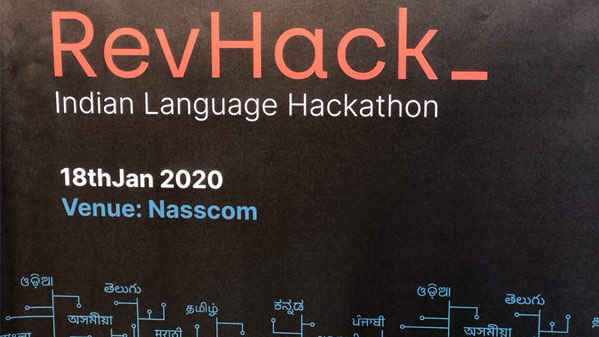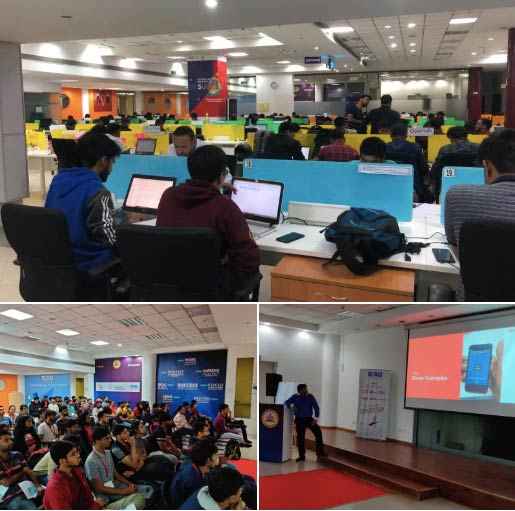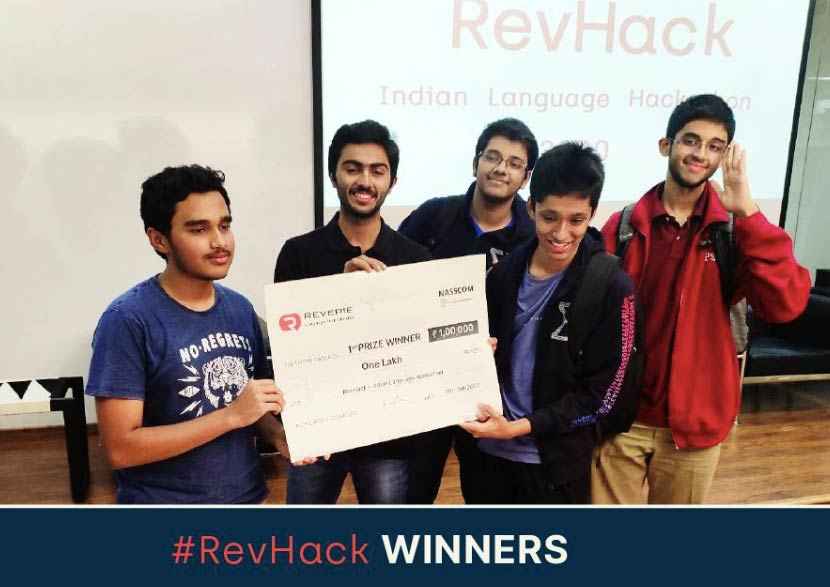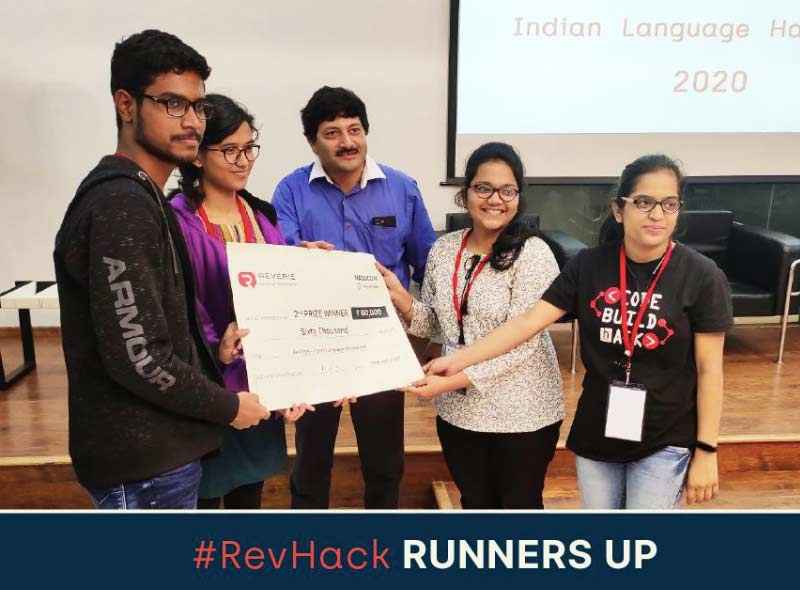Reverie hosts RevHack, a hackathon for developing Indic language technologies in Bengaluru

India has 22 scheduled or official languages with more than 10,000 speakers each, and yet most of the technologies available to Indians on a daily basis is available mostly in English. There is a big gap when it comes to the content and services available for Indic language users. Beyond information or forums, there are gaps in natural language interfaces, videos, games and applications as well. For native language speakers, the internet is almost an alien landscape. The question is not just about translating content in English to Indic languages, but creating the underlying technologies in local languages that allow Indic language speakers to create, publish, share and interact with content that is relevant to them, and is relevant to their sensibilities. Beyond smartphone apps and the internet, almost all the technologies that urban users interact with on a daily basis, including ATMs, ticket vending machines, automated water kiosks, vending machines, indicators on public transport, subway maps and so on are all in a limited number of languages, which can be confusing for Indic language speakers. Leading the charge in delivering local content in Indic languages is Reverie Language Technologies, a company that has been working with several businesses, as well as government agencies in delivering content and services in Indic languages to the underserved. On January 18, Reverie opened up its APIs to developers in a hackathon called RevHack at NASSCOM in Bengaluru, which was the first hackathon in India to focus exclusively on developing solutions for Indic language speakers.
 Survey
SurveyAddressing a unique problem
We spoke to one Arvind Pani, CEO and co-founder of Reverie Language Technologies, about the intent for the hackathon. “The basis of this hackathon was that we have a complete stack of technologies to address various aspects of user engagement in Indian languages,” Pani explained, “our company is a b2b company, and we expose this stack to companies which want to build user engagement experiences in Indian languages. We really wanted to expose this stack to the developer community. We cannot be ideating every single thing, and it is good if the community ideates and they can use our stack to build on top of those ideas. That was the reason why we had this hackathon.” To start with, over 150 people turned up for the hackathon, all focused on solving unique problems, which was an exceptional attendance according to Jonathan Bill, CEO and co-founder of Credit Mate, and one of the judges at RevHack. “It was pretty extraordinary I think”, Bill said, “the turnout was much larger than we had expected or hoped for, so that was great. Quite a diverse set of people coming to try and use Reverie’s APIs to address the language issues in India. There were some quite great ideas, and it was a fun day.“
Considering the specific and unique problem that the RevHack was addressing, it wasn’t just another hackathon where the developers and teams showed up to hone or showcase their skills. Everyone who participated were really interested in tackling the tricky problem, and coming up with unique solutions. When asked if the participants were passionate about the hackathon, Bill responded, “Yeah hugely. And that’s something that I think was exciting. Actually there were two things that happened. Previously perhaps it felt like perhaps a bit of an obligation, a bit like the way perhaps financial institutions treat Indic languages, which is that it is an obligation and that they have to do it. I think that the difference with the generation that we saw and that we interacted with, and generally on the internet in India now, we are seeing actually that it is a matter of opportunity to solve this problem. And if you solve that problem correctly, then the opportunity is not only exciting from an experience perspective, but it is also financially rewarding. The passion among the developers that came was very high. Pretty much, in fact we asked this question, a hundred percent of them were there because they wanted to help solve this problem, and not just because it was another hackathon.”
Jonathan Bill also made it a point to note the variety of people who showed up for the RevHack, “the thing that was very exciting for me was the diversity. We had people from all sorts of backgrounds and genders. I have been to hackathons before, and they are ninety nine percent male. Unusually, this one was kind of sixty I would say. That was encouraging as well. It may very well be that a different type of coder is attracted to solving this kind of problem, and that is what creates this kind of diversity.”
The RevHack in progress
The solutions developed
The winning team was a bunch of 11th standard students from National Public School in Bengaluru. These school children tackled two barriers of access to information at once, accessibility and local language content. They came up with a SaaS product that allows publishing houses to publish books in braille, in Indic languages, along with a user dictation component for the end user.
The team from The College of Engineering and Technology (TCE), Bhubaneshwar bagged the second prize, which simplified the form filling experience for Indic language speakers through a Google Chrome plugin. This was an idea that Jonathan Bill really liked as it eliminated agents who get paid to fill in these forms for Indic language speakers. Bill explains, “Let’s say you are filling in a form for a subsidy or a grant or something, the plugin helps you by reading out what the form says, and helping you to fill in the form correctly. As you may know, currently in India, because all forms are in one language, and not everyone can speak or read or write in that language, then a middleman exists, who takes a commission especially in smaller places. So this plugin helps in bypassing that.“
There were three consolation prizes. A team from Altisource developed a solution that uses text to speech and speech to text so that illiterate people can interact through voice, preventing dependence on intermediaries who might misrepresent the data. A team from the Ramaiah Institute of Technology in Bengaluru came up with an inventive solution for shoppers, especially for use in kirana stores in rural areas. The shopper simply dictates a shopping list, which is interpreted by an app with the shopkeeper, who can then dispatch the goods. The solution also supports payment through UPI. Keeping in mind the shopping habits of the individuals in local areas, the app additionally keeps track of the debt owed by each individual shopper. Over and above all this, the app tracks movement of goods, which can better help the Kirana store owner with inventory management. Since the entire app is voice based, it can as easily be used by visually impaired shoppers as well. A team from Dayananda Sagar University came up with an application that allows doctors and patients in rural areas to converse with each other, even if they are not familiar with the same language. This reduces the time taken for a consultation, and both the doctor as well as the patient can speak in the language that they are most comfortable with.
The RevHack Winning team from NPS, Bengaluru
Pani found the solutions developed extremely encouraging, “this was a huge success, and it was beyond our expectations. There were about 150 participants who came. We did not expect so many people to turn up for the hackathon. This is really encouraging, (they showed up) knowing very well that this is going to be a hackathon on Indian languages and Indian language technologies. Then it was also very encouraging that there were students not just from tech colleges, but there were students from schools also. As you can clearly see, the first prize winners were actually from a school. Folks thinking about solving problems for India and addressing the issue of language… because language is a key impediment to digital engagement in India, these are very encouraging finds. We hope that this trend continues, and it manifests in a real world business situation where people are also working towards resolving the issues around engagement in local languages. The quality of ideas, the number of participants, and the depth that they had gone into in some of the solutions that they worked on were all very encouraging.”
Bill explained how the solutions developed at the hackathon went beyond merely translation or transliteration, “it is a great theme, and timely. As we all know, if you look at the way the internet is growing in India and deepening its penetration, one of the major drivers of that is the ability for people to discover content in their own language. Typically, the businesses that are thriving in India and growing very fast are actually those based on local language content. TikTok would be a great example of that, where people are able to communicate naturally and easily in the language that they love, and the one that they are most comfortable expressing themselves in. On the Internet, text especially has started in English, with very minimal Indic language content, which has been somewhat disastrous if you ask me. The point I’m making is, where you give people the opportunity to communicate specially using voice, or song or humor, all of those things are more natural and more exciting for people in their local language. The same should be true for everybody.”
The runner's up from CET Bhubhneshwar with co-founder of Reverie, Vivekanand Pani
Reverie's APIs
When asked about the specific APIs developed by Reverie and how they were used in the hackathon, Pani replied, “This is a complete stack with various technologies addressing different aspects of user engagement. We have APIs for machine translation, which can be used to convert content dynamically in real-time from one language to multiple other languages. We also have APIs for speech to text, or ASR or automated speech recognition. We had also exposed APIs for our NLU, or natural language understanding. There are other technologies also that we are working on, but broadly, these are the ones that we had exposed to the developers during the hackathon.”
Pani went on to outline some of the ways in which Reverie’s APIs are being used, “companies are already using our technologies. We have been in existence for a while. Recently, Reliance acquired a majority stake in our company, and Reliance has been our customer for two and a half years. We work with the State Government and Central Government for g2c (government to citizen) engagement. We have done quite a bit of work in that space. We also work with enterprises. Practo has been using our APIs to book appointments with physicians in local languages. Ola’s drivers app has been localised by us, and 80 percent of their drivers all over India use it in their local languages. Then, we have localised the eNAM (National Agriculture Market) portal for the Ministry of Agriculture, it is a portal for the farmers where they can access information and trade as well. GeM (Government eMarketplace) is a procurement marketplace for any kind of goods and services that are required by the State Government and Central Government. That has been localised by us. Our APIs have been available in various capacities, and we continue to work on newer technologies. So businesses have been using it, and we want more and more businesses as well as government entities to continue using our technologies.”
Credit Mate also uses Reverie’s API. Bill explains, “we are working with Reverie as we speak, we currently offer our services in eight Indian languages in text, and seven in voice. The next thing that we are building on top of Reverie’s API is intelligence around conversations. We are a collection business, and we speak to customers all around India who have overdue payments. One thing that we want to deliver is a short and optimal customer and borrower experience. So it is very important for us to understand not only the tonality of the conversation, but also what is being said in those conversations to ensure a better borrower experience. Any incorrect or inappropriate language is flagged, and that we can understand and perhaps change the conversation with the customers based on their responses to us. We are very excited about speech to text and natural language processing.”
What is currently a gap when it comes to making technologies available to the underserved, can easily be turned into something where India leads the way. Users in India switch between multiple languages more easily, the languages are very different from each other, there are a number of scripts, and India will just require a lot of unique and interesting technologies to be developed, which can have global implications for the consumption and creation of multimedia experiences. According to Jonathan, “there are certain companies working on that alongside Reverie. Google is trying to help by producing some technologies as well. I think one of the biggest and most interesting developments are where India may actually leapfrog other markets, is the video and speech area. I think that these are the technologies around text to speech or speech to text, and natural language processing, understanding intent, being able to switch easily between languages spoken. For example, of the billions of calls that happen between call centers and customers every day, the content in YouTube, and indeed just phone calls, those are really interesting areas. I think India may end up being a little bit more voice and spoken language centric, which is a vanguard area for the world, as much as it is around text, and just translating English text into multiple languages.”
We also quizzed Credit Mate CEO about perhaps a hesitancy or an unwillingness to pay for applications and technologies that may be preventing the adoption of Indic language technologies in India. However, this is simply not a problem according to Bill, “I don’t think an absence of business opportunity is a barrier, I think an absence of a platform or an easy tools to enable you to develop in multiple languages has been the barrier. If I have a business operating in all of Europe for example, it is very normal for me, it is very basic hygiene to have my website in all European languages. In India, there are very few websites or apps that give you the choice of operating in seven or eight major Indic languages. These are basic features. What businesses are discovering is that where they do actively serve those customers in local languages, then they are getting a better response and uptake. Therefore, they get an advantage over the businesses that predominantly only use English. The argument is that comes from being a nice to have, I think, to a must have.”
After the success of the first RevHack, Reverie plans to have additional hackathons across the country, with a particular focus on tier II and tier III towns and villages. When asked if Reverie was planning on follow up RevHacks, Pani emphatically said “Yes, we are. This was the first ever hackathon, but we will be doing more such hackathons going forward as well. Not just in Bengaluru, but we plan to do that in other cities as well. We will certainly experiment doing this in smaller cities, because in smaller cities not many opportunities are there to have such kind of tech hackathons. I believe that the smaller cities are a lot closer to the realities of the challenges that users face as far as local languages are concerned. There might be very interesting ideas that come from smaller cities as well.”
Aditya Madanapalle
Aditya Madanapalle, has studied journalism, multimedia technologies and ancient runes, used to make the covermount DVDs when they were still a thing, but now focuses on the science stories and features. View Full Profile


